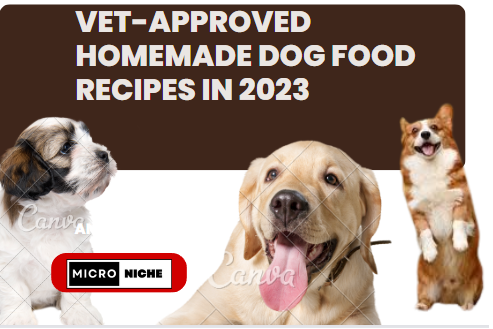Introduction
Discover vet-approved homemade dog food recipes for a healthier pup in 2023. Spoil your furry friend with nutritious and delicious meals crafted with love.
In the ever-evolving landscape of pet care, one trend stands out—homemade dog food. As pet owners become increasingly conscious of their furry companions’ well-being, the demand for vet-approved homemade dog food recipes continues to soar. In this guide, we unveil a collection of delectable and nutritious recipes that not only satisfy your dog’s taste buds but also adhere to veterinary standards. Say goodbye to store-bought kibble and embark on a culinary journey to pamper your pup with wholesome goodness.
1: The Importance of Vet-Approved homemade Dog Food
Crafting homemade meals for your dog may seem like a laborious task, but the benefits far outweigh the effort. Vet-approved recipes ensure that your furry friend receives a well-balanced diet tailored to its specific needs. From essential nutrients to portion control, these recipes cater to your dog’s health and happiness.

2: Nutrient-Rich Delights for Your Pup
Chicken and Sweet Potato Delight
Start your dog’s culinary adventure with a protein-packed dish. Combine lean chicken, sweet potatoes, and a sprinkle of turmeric for an anti-inflammatory boost. This vet-approved recipe provides the necessary proteins and carbohydrates for sustained energy.
Salmon and Quinoa Feast
For a dose of omega-3 fatty acids, try a salmon and quinoa delight. This recipe supports a healthy coat and joint function. Add a mix of colorful vegetables for added vitamins and minerals.
3: DIY Dog Food – A Tail-Wagging Experience
Creating homemade dog food not only ensures nutritional value but also strengthens the bond between you and your four-legged companion.
4: Benefits of Vet-Approved Homemade Dog Food
Tailored Nutrition
Commercial dog foods often take a one-size-fits-all approach. Homemade recipes allow you to tailor your dog’s diet to its individual needs, addressing allergies, sensitivities, and health conditions.
Quality Control
Know exactly what goes into your dog’s bowl. With homemade recipes, you have complete control over the quality of ingredients, eliminating additives and preservatives that may harm your pet.
5: Choose High-Quality Ingredients
The Foundation of a Nutritious Meal
When preparing homemade dog food, prioritize high-quality ingredients. Opt for lean proteins like chicken, turkey, or fish, and include a variety of vegetables such as carrots, spinach, and sweet potatoes. These elements form the foundation of a nutritious and well-balanced meal for your furry friend.
Whole Grains for Sustained Energy
Incorporate whole grains like brown rice or quinoa to provide a steady release of energy. These grains are rich in fiber and essential nutrients, supporting your dog’s digestive health and overall well-being.
6: Portion Control Matters
Tailor Serving Sizes to Your Dog’s Needs
Avoid overfeeding by carefully measuring portions according to your dog’s size, age, and activity level. Consult your veterinarian to determine the appropriate serving sizes to maintain a healthy weight and lifestyle for your canine companion.
Monitor Your Dog’s Weight
Regularly assess your dog’s weight and adjust portion sizes accordingly. Homemade dog food allows you to fine-tune servings based on your pet’s individual requirements, ensuring they stay in optimal health.
7: Supplementing the Right Way
Essential Supplements
While homemade dog food provides a wealth of nutrients, it’s essential to consider supplements. Omega-3 fatty acids, vitamins, and minerals may need supplementation, depending on your dog’s specific needs. Consult your vet to determine the appropriate supplements for your furry friend.
Rotate Ingredients for Variety
Varying protein sources and rotating vegetables ensures a broad spectrum of nutrients. This diversity not only promotes a well-balanced diet but also adds excitement to your dog’s mealtime.
FAQs:
1. Is homemade dog food nutritionally balanced?
Yes, when following vet-approved recipes, homemade dog food can provide a well-balanced diet. Consult your veterinarian to ensure the recipes meet your dog’s specific nutritional needs.
2. Can I use any ingredients for homemade dog food?
While there is flexibility, it’s crucial to use vet-approved ingredients. Avoid toxic foods for dogs, such as onions, garlic, and certain spices. Opt for lean meats, whole grains, and a variety of vegetables.
3. How do I transition my dog to homemade food?
Gradually introduce homemade meals by mixing them with your dog’s current food. Monitor their reaction and consult your vet for any necessary adjustments.
4. Are there any risks associated with homemade dog food?
Improperly balanced homemade diets can pose risks. It’s essential to follow vet-approved recipes and consult your veterinarian to ensure your dog’s nutritional needs are met.

